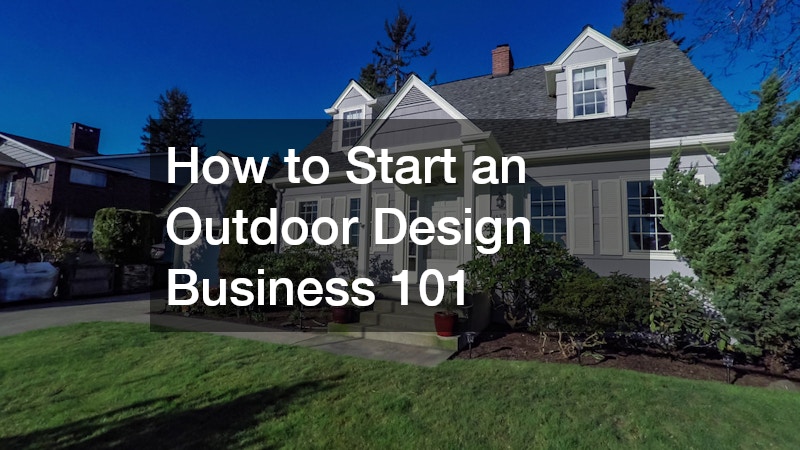Starting a successful outdoor design venture requires more than a sketchbook and enthusiasm. You’ll need a clear plan, financial discipline, and the patience to nurture relationships while tackling ever-shifting customer expectations. Because the landscape business touches everything from soil science to project management, outlining a comprehensive launch roadmap protects you from costly missteps and builds brand credibility from day one. Over the next several sections, you’ll learn how to translate creativity into profit, position services strategically, and run operations that scale without sacrificing craftsmanship.
Establishing a new company always involves risk, but strategic preparation mitigates surprises. Seasoned landscape designers agree that aspiring owners should invest early in detailed market research, sustainable growth models, and systems that balance artistry with repeatable processes. When you combine those fundamentals with premium lawn care outcomes, long-term client trust follows naturally—even in saturated regions where competitors promise instant transformations.
Define Your Vision and Niche
Clarity fuels momentum, so begin by articulating exactly which spaces you want to transform and why. Maybe you picture intimate gardens accented by backyard hardscaping service elements such as natural stone patios or meandering paths framed by decorative fences. Or perhaps your passion lies in restoring urban courtyards into pollinator havens that double as entertaining hubs. A focused niche guides equipment purchases, marketing language, and partnerships, ensuring every dollar spent advances your signature style rather than chasing trends.
Map Out a Business Plan
A robust plan covers revenue goals, projected expenses, and contingency funds for seasonal slowdowns. Start with service tiers—basic maintenance, thematic plantings, and full design-build packages—and price them for profit after labor, materials, and overhead. If you plan to install irrigation controllers or source native plants wholesale, note suppliers and delivery timelines. Including a lease-to-own option for a commercial-grade lawn mower avoids draining cash reserves, preserves credit, and keeps you nimble as bookings grow.
Confirm Legal Structure, Licensing, and Insurance
Choose between sole proprietorship, LLC, or corporation with an accountant’s guidance, then secure local contractor licenses and any specialty certifications for installing french drains or low-voltage lighting. Don’t skimp on general liability or workers’ compensation; comprehensive coverage reassures homeowners who trust you with costly landscape features and recurring lawn care visits. A well-written service agreement further clarifies scope, payment schedules, and warranty terms—reducing misunderstandings that can derail brand reputation before it takes root.
Budget for Tools and Equipment
Efficient crews rely on sharp spades, calibrated spreaders, and reliable trucks fitted with lockable toolboxes. Resist the temptation to buy every attachment at once; instead, build an essentials list and add specialty gear—like trenchers for outdoor water features—once consistent demand materializes. Upgrading to a commercial-grade lawn mower may feel extravagant initially, yet the time saved on each maintenance stop improves margins and frees bandwidth for higher-value design consultations.
Build an Inspiring Portfolio
Impeccable visuals sell faster than technical jargon. Photograph each finished patio from multiple angles, showcasing how sun-dappled seating contrasts with smooth pavers or how delicate vines soften decorative fences. Potential clients quickly envision similar results on their property and trust your eye for detail. Experienced landscape designers recommend documenting the progression from rough sketches to polished backyard hardscaping service installations, underscoring mastery of both concept and execution.
Satisfied homeowners often volunteer enthusiastic testimonials—ask permission to pair their words with images for added credibility. Compile these stories into a digital lookbook and printed booklet alike, reinforcing expertise during in-person consultations and virtual inquiries.
Price Models That Protect Profit
Transparent, tiered pricing reassures prospects and wards off scope creep. Break projects into phases—concept development, hardscape construction, and planting—so clients can pause between milestones without derailing your cash flow. When material costs spike, consider sourcing through a local irrigation company that offers volume discounts on valves and controllers. Bundling essential add-ons such as property-specific decorative fences into premium packages can elevate perceived value while safeguarding healthy margins.
Hire and Train Your Team
Exceptional results hinge on skilled, motivated staff. Invest in cross-training so each installer grasps both grading principles and efficient irrigation setup, keeping timelines intact when schedules shift. Provide safety workshops on trenching hazards around existing french drains, plus leadership courses for crew chiefs who oversee multiple job sites. Encouraging professional development cultivates loyalty, reducing turnover at peak planting season.
Market Strategically to Attract Clients
Authentic storytelling outperforms generic ads. Share before-and-after reels of tranquil patios enhanced by meandering outdoor water features, or time-lapse clips of barren yards transformed into cozy entertaining spaces under twinkling café lights. Align those visuals with blog posts outlining core values, sustainable practices, and the artistry behind your landscape business. Over time, word-of-mouth referrals supplement leads generated through social channels, search-engine optimization, and community sponsorships.
A second marketing pillar focuses on partnerships. Collaborate with boutique nurseries, outdoor furniture retailers, or property-management firms that serve your ideal demographic. When their customers crave full-service makeovers, your brand becomes the trusted solution, expanding reach without hefty advertising spends.
Integrate Sustainable Practices
Eco-conscious solutions resonate with property owners who value longevity and regional stewardship. Offer soil testing, regenerate depleted beds with organic compost, and suggest low-flow fixtures provided by a reputable local irrigation company. Native plant palettes thrive on minimal inputs, while well-placed rain gardens relieve pressure on municipal systems and complement subsurface french drains. Eco-friendly credentials can justify modest premium fees, positioning your firm as an innovator rather than a commodity provider.
Extending sustainability into daily routines also pays dividends. Route optimization software trims fuel costs, while battery-powered trimmers quiet early-morning starts. Brand-wide commitment sets you apart in markets where residents increasingly weigh carbon footprints alongside aesthetics when selecting lawn care providers.
Create Operational Workflows and Schedules
Smooth logistics protect profits. Build a master calendar that staggers design consultations, excavation, planting, and maintenance stops logically. Allocate buffers for weather delays, then assign crews and resources—like a specialized trencher for extended irrigation runs—accordingly. Routine checks on each lawn mower and trencher prevent breakdowns mid-project, keeping promises intact.
Software integrations tie purchase orders, time tracking, and invoicing into one dashboard. Real-time updates empower project managers to pivot crews when unforeseen issues—say, a hidden drainpipe intersection with new french drains—demand attention.
Deliver Exceptional Client Experiences
Communication drives loyalty more than flawless plant spacing. Provide weekly status emails with high-resolution images illustrating progress on backyard hardscaping service elements or newly installed accent lighting along decorative fences. Make crew leads easily reachable for quick clarifications. When property owners feel respected, they confidently approve change orders, enhancing project scope and revenue.
Seasonal follow-ups extend relationships beyond installation. Offering winterization, leaf removal, or deep-root fertilization packages positions your team as the all-season authority—an important upsell once initial enthusiasm settles into routine ownership.
Scale with Technology and Partnerships
Cloud-hosted design software accelerates 3-D renderings and integrates plant libraries tailored to your hardiness zone. Customer-relationship-management tools automate maintenance reminders, ensuring existing clients book spring lawn care tune-ups and pump-down services for outdoor water features. Formal alliances with a local irrigation company or masonry outfit streamline bids and expedite timelines, boosting referral volume on both sides of the collaboration.
Track Metrics and Continuously Improve
Numbers tell the story behind stunning Instagram grids. Monitor average profit per project, referral percentage, and labor-cost variance across service categories. If subsurface french drains produce higher margins than patio builds, consider emphasizing them in seasonal campaigns. Similarly, track conversion rates on leads generated by content featuring decorative fences versus pollinator beds to refine ad spend.
Quarterly retrospectives with crew leads surface insights on process bottlenecks—perhaps lengthy unloading times or duplication of effort during irrigation start-ups. Implement new checklists or adjust crew sizes, then measure impact to validate improvements.
Cultivate Growth One Project at a Time
Launching an outdoor design enterprise pairs creativity with disciplined operations. Clarify your mission, price transparently, and train crews rigorously. Equip them to execute everything from precision grading to meticulous backyard hardscaping service layouts, supported by efficient tools and a client-first ethos. Steady refinement of workflows, proactive safety measures, and eco-friendly solutions—whether drought-adaptive plantings or water-saving local irrigation company installations—keep your brand resilient in dynamic markets.
Sustainable expansion doesn’t happen overnight, but with each vibrant garden border, expertly routed decorative fences segmenting zones, and harmonious outdoor water features settling pond ripples, your reputation will rise. Consistently exceed expectations, track metrics faithfully, and champion environmental stewardship, and your landscape business will flourish—turning visions into living canvases while securing enduring client loyalty.






